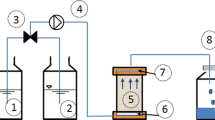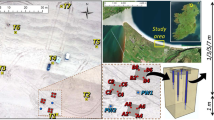Abstract
Knowledge of the saturated hydraulic conductivity (K sat) of porous filters used in water treatment technologies is important for optimizing the retention of nutrients and pollutants. This parameter determines the hydraulic capacity, which together with the chemical properties of the filter media, affects the treatment performance of the filter system. However, measuring K sat is time consuming and expensive. This study developed a novel transfer function to predict K sat of coarse porous media from easily measured parameters. The hydro-physical parameters determined were K sat, grain size distribution, bulk density, uniformity coefficient, particle density, and porosity of 46 porous media fractions. The fractions ranged in grain size from 0.5 to 20 mm and were obtained from seven commercial available coarse filter materials. A backward stepwise regression analysis was performed between K sat and 10 variables obtained from the grain size distribution and bulk density. The optimal model for predicting K sat contained two parameters, D20 and D50, which describe respectively the particle diameters, where 20 and 50 % of all particles are finer by weight. The predicted K sat values were in good agreement with the measured values (R 2 = 0.91). The transfer function can find potential usage in relation to dimensioning of permeable agricultural drainage filters or subsurface-flow constructed wetlands. The predicted values of K sat can also be used as input to numerical models that simulate filter treatment performance.





Similar content being viewed by others
Abbreviations
- D x :
-
Grain size diameter, where x % of all particles are finer by weight
- U C :
-
Coefficient of uniformity, U C = D60/D10
- K sat :
-
Saturated hydraulic conductivity
- A :
-
Cross-sectional area
- q :
-
Darcy Flux
- Q :
-
Water discharge
- L :
-
Length of the column filter
- ΔH:
-
Hydraulic head
- n :
-
Number of replicates
- N :
-
Number of data (fractions)
- ρ b :
-
Dry bulk density
- ρ s :
-
Particle (solid) density
- θ tot :
-
Total porosity
References
Alyamani, M. S., & Sen, Z. (1993). Determination of hydraulic conductivity from complete grain-size distribution curves. Ground Water, 31(4), 551–555. doi:10.1111/j.1745-6584.1993.tb00587.x.
Arias, C. A., & Brix, H. (2005). Phosphorus removal in constructed wetlands: can suitable alternative media be identified? Water Science and Technology, 51(9), 267–273.
Arias, C. A., Del Bubba, M., & Brix, H. (2001). Phosphorus removal by sands for use as media in subsurface flow constructed reed beds. Water Research, 35(5), 1159–1168.
Arya, L. M., Heitman, J. L., Thapa, B. B., & Bowman, D. C. (2010). Predicting saturated hydraulic conductivity of golf course sands from particle-size distribution. Soil Science Society of America Journal, 74(1), 33–37. doi:10.2136/sssaj2009.0022.
Boadu, F. K. (2000). Hydraulic conductivity of soils from grain-size distribution: new models. Journal of Geotechnical and Geoenvironmental Engineering, 126(8), 739–746. doi:10.1061/(asce)1090-0241(2000)126:8(739).
Buda, A. R., Koopmans, G. F., Bryant, R. B., & Chardon, W. J. (2012). Emerging technologies for removing nonpoint phosphorus from surface water and groundwater: introduction. Journal of Environmental Quality, 41(3), 621–627. doi:10.2134/jeq2012.0080.
Carmen, P. C. (1937). Fluid flow through granular beds. Transactions of the American Institute of Chemical Engineers, 15, 150–166.
Chardon, W. J., Groenenberg, J. E., Temminghoff, E. J. M., & Koopmans, G. F. (2012). Use of reactive materials to bind phosphorus. Journal of Environmental Quality, 41(3), 636–646. doi:10.2134/jeq2011.0055.
Elrick, D. E., Sheard, R. W., & Baumgartner, N. (1981). A simple procedure for determining the hydraulic conductivity and water retention of putting green soil mixtures. International Turfgrass Society Research Journal, 4, 189–200.
Fallico, C., De Bartolo, S., Troisi, S., & Veltri, M. (2010). Scaling analysis of hydraulic conductivity and porosity on a sandy medium of an unconfined aquifer reproduced in the laboratory. Geoderma, 160(1), 3–12. doi:10.1016/j.geoderma.2010.09.014.
Flint, A. L., & Flint, L. E. (2002). Particle density. In J. H. Dane & G. C. Topp (Eds.), Methods of soil analysis. Part 4. Physical methods (Vol. 5, pp. 229–240). Madison: Soil Science Society of America.
Glantz, S. A. (2005). Primer of biostatistics. New York: McGraw-Hill Medical.
Iversen, B. V., Borgesen, C. D., Laegdsmand, M., Greve, M. H., Heckrath, G., & Kjaergaard, C. (2011). Risk predicting of macropore flow using pedotransfer functions, textural maps, and modeling. Vadose Zone Journal, 10(4), 1185–1195. doi:10.2136/vzj2010.0140.
Jabro, J. D. (1992). Estimation of saturated hydraulic conductivity of soils from particle-size distribution and bulk-density data. Transactions of the Asae, 35(2), 557–560.
Kadlec, R. H., & Wallace, S. (2009). Hydrology and hydraulics. In Treatment wetlands (2nd ed., pp. 21–57). Boca Raton: CRC Press.
Klute, A. (1965). Laboratory measurement of hydraulic conductivity of saturated soil. In C. A. Black (Ed.), Methods of soil analysis, part 1. Agronomy 9 (pp. 210–221). Madison: American Society of Agronomist.
Knowles, P. R., Griffin, P., & Davies, P. A. (2010). Complementary methods to investigate the development of clogging within a horizontal sub-surface flow tertiary treatment wetland. Water Research, 44(1), 320–330. doi:10.1016/j.watres.2009.09.028.
Langergraber, G., Haberl, R., Laber, J., & Pressl, A. (2003). Evaluation of substrate clogging processes in vertical flow constructed wetlands. Water Science and Technology, 48(5), 25–34.
Le Coustumer, S., Fletcher, T. D., Deletic, A., Barraud, S., & Poelsma, P. (2012). The influence of design parameters on clogging of stormwater biofilters: a large-scale column study. Water Research, 46(20), 6743–6752. doi:10.1016/j.watres.2012.01.026.
Lebron, I., Schaap, M. G., & Suarez, D. L. (1999). Saturated hydraulic conductivity prediction from microscopic pore geometry measurements and neural network analysis. Water Resources Research, 35(10), 3149–3158. doi:10.1029/1999WR900195.
Mbonimpa, M., Aubertin, M., Chapuis, R. P., & Bussière, B. (2002). Practical pedotransfer functions for estimating the saturated hydraulic conductivity. Geotechnical & Geological Engineering, 20(3), 235–259. doi:10.1023/A:1016046214724.
McDowell, R. W., Sharpley, A. N., & Bourke, W. (2008). Treatment of drainage water with industrial by-products to prevent phosphorus loss from tile-drained land. Journal of Environmental Quality, 37(4), 1575–1582. doi:10.2134/jeq2007.0454.
McDowell-Boyer, L. M., Hunt, J. R., & Sitar, N. (1986). Particle transport through porous media. Water Resources Research, 22(13), 1901–1921. doi:10.1029/WR022i013p01901.
McIntyre, B. D., & Riha, S. J. (1991). Hydraulic conductivity and nitrogen removal in an artificial wetland system. Journal of Environmental Quality, 20(1), 259–263. doi:10.2134/jeq1991.00472425002000010042x.
Penn, C. J., & McGrath, J. M. (2011). Predicting phosphorus sorption onto steel slag using a flow-through approach with application to a pilot scale system. Journal of Water Resource and Protection, 3(4), 235–244. doi:10.4236/jwarp.2011.34030.
Penn, C. J., Bryant, R. B., Kleinman, P. J. A., & Allen, A. L. (2007). Removing dissolved phosphorus from drainage ditch water with phosphorus sorbing materials. Journal of Soil and Water Conservation, 62(4), 269–276.
Penn, C. J., McGrath, J. M., Rounds, E., Fox, G., & Heeren, D. (2012). Trapping phosphorus in runoff with a phosphorus removal structure. Journal of Environmental Quality, 41(3), 672–679. doi:10.2134/jeq2011.0045.
Rawls, W. J., Gimenez, D., & Grossman, R. (1998). Use of soil texture, bulk density, and slope of the water retention curve to predict saturated hydraulic conductivity. Transactions of the Asae, 41(4), 983–988.
Reynolds, W. D., Elrick, D. E., Youngs, E. G., Amoozegar, A., Booltink, H. W., & Bouma, J. (2002). Saturated and field-saturated water flow parameters. In J. H. Dane & G. C. Topp (Eds.), Methods of soil analysis. Part 4. Physical methods (Vol. 5, pp. 797–878). Madison: Soil Science Society of America.
Saint-Gobain, W. A. S. (2002). Technical specification for the use of lightweight expanded clay aggregate (Optiroc LWA) as a structural backfill material.
Sanford, W. E., Steenhuis, T. S., Parlange, J. Y., Surface, J. M., & Peverly, J. H. (1995). Hydraulic conductivity of gravel and sand as substrates in rock-reed filters. Ecological Engineering, 4(4), 321–336. doi:10.1016/0925-8574(95)00004-3.
Schaap, M. G., & Lebron, I. (2001). Using microscope observations of thin sections to estimate soil permeability with the Kozeny–Carman equation. Journal of Hydrology, 251(3–4), 186–201. doi:10.1016/S0022-1694(01)00468-1.
Stoner, D., Penn, C., McGrath, J., & Warren, J. (2012). Phosphorus removal with by-products in a flow-through setting. Journal of Environmental Quality, 41(3), 654–663. doi:10.2134/jeq2011.0049.
Trani, L. D. O., & Indraratna, B. (2010). The use of particle size distribution by surface area method in predicting the saturated hydraulic conductivity of graded granular soils. Geotechnique, 60(12), 957–962. doi:10.1680/geot.9.T.014.
Vukovic, M., & Soro, A. (1992). Determination of hydraulic conductivity of porous media from grain-size composition. Littleton: Water Resource Publications.
Vymazal, J. (2008). Constructed wetlands, subsurface flow. In J. Sven Erik & F. Brian (Eds.), Encyclopedia of ecology (pp. 748–764). Oxford: Academic Press.
Webb, P. A. (2001). Volume and density determinations for particle technologists. Micromeritics Instrument Corp. (pp. 1–16). Norcross, Georgia, USA.
Acknowledgments
The project was funded by the Danish Strategic Research Council, grant no. 09–067280 (SupremeTech, www.supremetech.dk). We would like to acknowledge the following people from the Department of Agroecology, Aarhus University: Michael Koppelgaard for the valuable contribution on designing and constructing the K sat equipment, and Per Drøscher and Morten Skov for their technical support on the equipment construction. Thank you also to Feto E. Berisso for fruitful suggestions during data elaboration.
Author information
Authors and Affiliations
Corresponding author
Rights and permissions
About this article
Cite this article
Canga, E., Iversen, B.V. & Kjaergaard, C. A Simplified Transfer Function for Estimating Saturated Hydraulic Conductivity of Porous Drainage Filters. Water Air Soil Pollut 225, 1794 (2014). https://doi.org/10.1007/s11270-013-1794-8
Received:
Accepted:
Published:
DOI: https://doi.org/10.1007/s11270-013-1794-8




